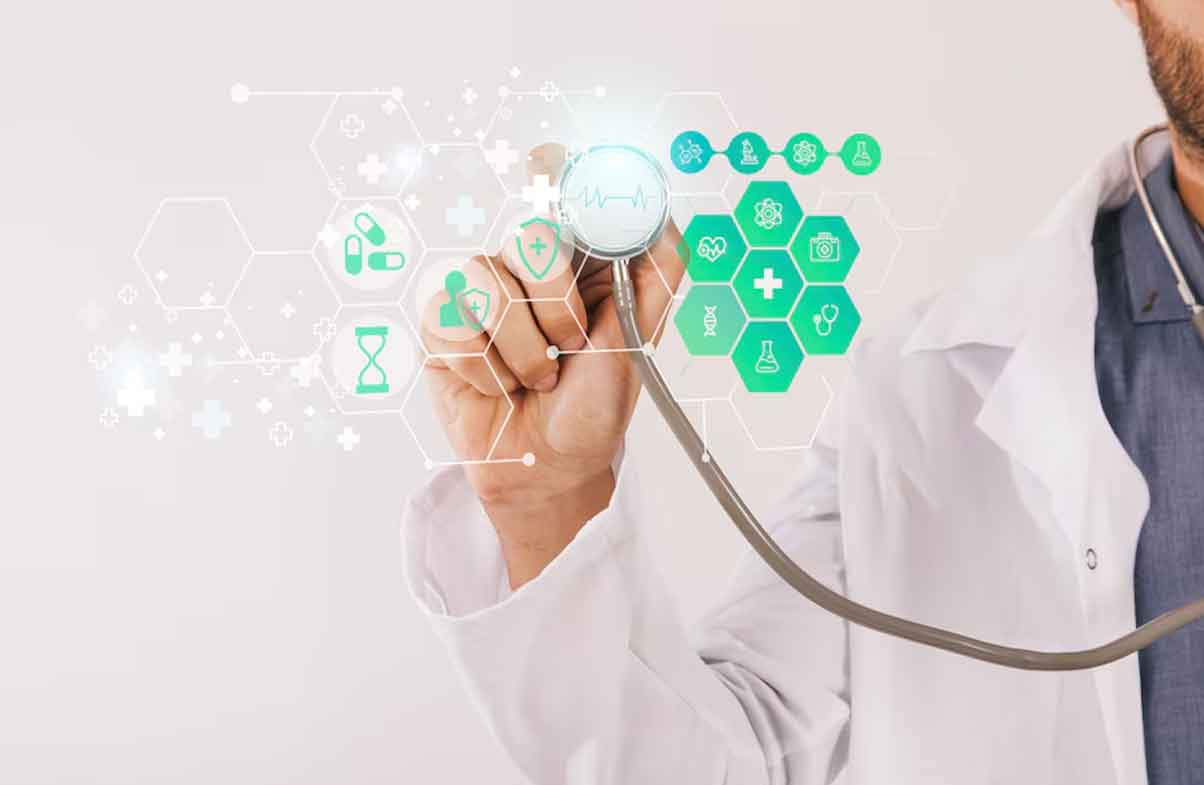IoT and AI in the Healthcare

10 Jan 2025
IoT and AI in Healthcare
Technological advancement is fast-paced. In revolutionary alterations in the field of healthcare, artificial intelligence combined with the Internet of Things (IoT) is one of the most influential technologies. Diagnosis and treatment of diseases have been made quite easier, while it transforms patient care, efficacy in operation, and methodology using technological devices for medical research.
The integration of the competence of IoT in collecting data and the ability of AI to analyze that data is enabling the best fit intelligent healthcare ecosystem because the two complement each other perfectly. This blog explains IoT and AI in the healthcare industry and the challenges and ethical considerations that must be taken into account.
IoT: Bridging the Physical and Digital Worlds
All that IoT does is link devices together, and sensors within an area of the healthcare industry. It's basic cum easy to manage, connecting to personal devices, complete systems in a way to facilitate the seamless collaboration of information. This process gathers real-time data and early decision-making on medical services and its matters, such as the diagnosis of a disease.
Remote Patient Monitoring or RPM:
Some of the IoT-enabled devices that would allow remote patient monitoring include smartwatches, fitness bands, and other wearables such as ECG monitors that will help to check the heart rate, blood pressure, oxygen saturation, etc. The collected data is sent to health professionals for close patient monitoring and the necessity of timely intervention as required. The typical home for such devices would be the older generation, with many of them living far away from health facilities.
Improved Patient Engagement:
Smart wearables, fitness bands, or even portable ECG monitors are common examples of IoT devices that have taken tracking a step further as they monitor heart rate, blood pressure, and oxygen saturation levels and send this data to medical practitioners for timely intervention. Its value is priceless for older patients or anyone living in a remote area without easy access to health facilities.
Enhanced Asset Management:
Hospitals and clinics are often bogged down by their medical equipment, especially when remembering some critical, yet easily movable equipment such as ventilators, wheelchairs, or infusion pumps. Such items can now be installed with IoT-enabled sensors at the time they have been attached to the medical devices and provide real-time location and usage data; therefore, they ensure availability at the time of need and ensure preventive maintenance to avoid downtime.
AI: The Brain Behind the Operation
Artificial Intelligence (AI) is the intelligence and depth behind data coming from such IoT devices. Scanning through huge databases, AI algorithms can find hidden patterns in data, predict certain outcomes, and then derive recommendations based on those findings.
Medical Imaging:
Medical imaging's transformation because of artificial intelligence-powered applications has demonstrated its versatility in diagnostics. For instance, an X-ray, CT scan, or MRI analysis can now present the earliest signs of cancer, heart disease, or a neurological disorder with the help of AI applications and algorithms. This is destined to improve diagnosis and lessen radiologists' workloads.
Predictive Analytics:
The AI models for predictive analytics look at past and real-time data to detect future potential health problems. For example, it can also analyze the trends in vital signs of the patient as input and predict the probability of a heart attack, resulting in preemptive care and possibly saving lives.
Natural Language Processing (NLP):
AI-powered NLP applications provide simplified administrative access points in healthcare. For example, automated medical billing and coding scripts may be included in the transcription of doctor-patient conversations. This eliminates the needless paperwork burden and frees up the healthcare provider to spend more time with the patient.
Relationship Between IoT and AI
The result has to be very transformative when IoT and AI come together. IoT works on collecting a huge amount of data, while AI processes this data and generates actionable insights. This combination improves the efficiency and personalization of healthcare delivery.
Case Study: Smart Insulin Pumps
A prime example of this collaboration is smart insulin pumps used by diabetic patients. They keep a constant glucose level watch through IoT sensors and adjust the insulin amount in real time through AI algorithms, which reduces the chances of complications and makes life better for the patient.
Telemedicine Evolution:
Effective communication may be treated as imaginary with AI-powered diagnostics and IoT-enabled mobile devices. Wearable devices would send real-time health stats to doctors, and the AI would analyze them to assist in diagnostic processes during a telemedicine appointment. This suits particularly well in sparsely populated or underserved areas where the reach of health services is somewhat limited.
Challenges and Ethical Considerations
While there is great promise in developing IoT and AI-integrated healthcare, it also poses numerous challenges that require addressing:
Data Security and Privacy:
Healthcare data is very sensitive, and the collection and transmission of such information wirelessly through IoT devices render it particularly vulnerable to attacks from the cyber world. Security measures should include encryption, secure storage of data, and data compliance with regulations like HIPAA.
Interoperability Issues:
Different systems operate in distinct, incompatible platforms among devices in IoT. Data so builds silos of information across organizations in healthcare. A universal standardization of interoperability then becomes very important for the seamless data sharing across the healthcare system.
Algorithm Transparency:
AI's decision-making processes can be extremely complex and opaque, posing challenges for healthcare providers in comprehending or trusting the recommendations provided by AI. Trust and ethical use can be guaranteed with transparent AI models and explainable AI (XAI).
The Road Ahead
The infusion of IoT with AI leads to the future of healthcare, smarter hospitals, personalized treatments, and improved patient outcomes. Investing the advanced tech and resources must remain in ethical deployment and what redounds to profit of well-being to patients.
At NanoByte Technologies, we are doing great things in establishing paradigm-shifting solutions for IoT and AI in the healthcare sector, from intelligent device integration to advanced analytics and much more.
FAQs
1. How does IoT improve patient care?
It facilitates telemedicine consultations, early detection of health issues, and continuous tracking with the help of wearables. For instance, IoT can alert caregivers to sudden changes in a patient's vitals, enabling a quick response.
2. Can AI replace doctors?
AI is not created to displace doctors but to widen their horizons. AI sees data and presents analysis, but clinical judgment and patients' connections remain irreplaceable components of healthcare.
3. What are the security risks associated with IoT in healthcare?
IoT devices in healthcare are open to harm through cyber attacks, data breaches, or unauthorized access. Deploying effective encryption, secure networks, and regulatory frameworks is effective in the mitigation of these risks.
4. How can IoT and AI reduce healthcare costs?
Healthcare IoT devices are vulnerable to illegal access, data breaches, and cyberattacks. One of the operational benefits would be the reduction of repair costs and downtime through predictive maintenance of medical equipment utilizing IoT sensors.
5. What is the role of AI in drug discovery?
AI speeds up drug discovery by finding promising chemicals in vast volumes of data, forecasting their effectiveness, and enhancing clinical trials. This reduces the amount of time and money required to develop and launch the product.



.jpg)

